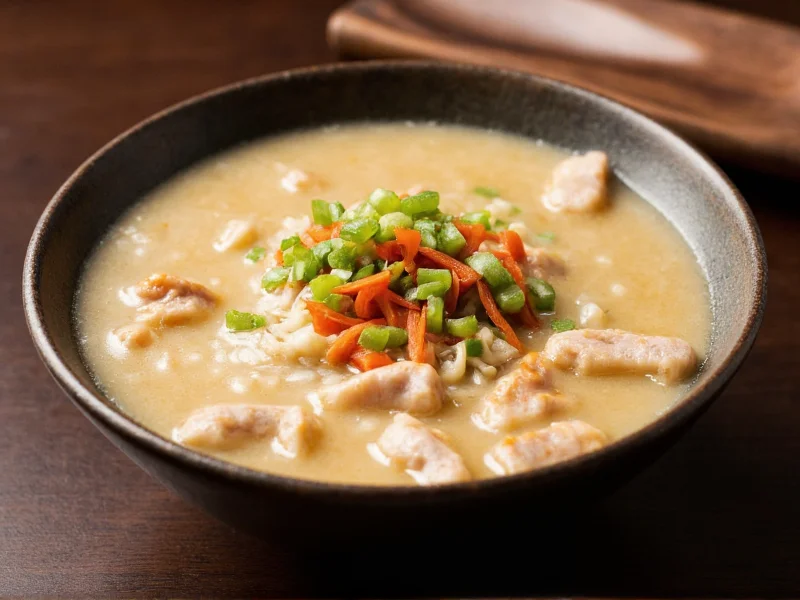Tonkotsu soup is a rich, creamy Japanese ramen featuring a milky-white broth made by boiling pork bones for many hours. This distinctive ramen variety originated in Fukuoka, Kyushu, and is characterized by its intense pork flavor, thick consistency, and opaque appearance resulting from emulsified bone marrow and collagen.
When you encounter a bowl of authentic tonkotsu ramen, you're experiencing one of Japan's most beloved comfort foods with a surprisingly complex preparation process. Unlike other ramen styles that use clear broths, tonkotsu's signature cloudy appearance comes from the meticulous boiling of pork bones—typically femurs and trotters—for 12-18 hours at a vigorous boil. This extended cooking time extracts collagen, marrow, and proteins that emulsify into the broth, creating its characteristic thickness and rich mouthfeel.
The Origins of Tonkotsu Ramen
Tonkotsu soup emerged in the 1930s in Kurume, Fukuoka Prefecture on Japan's southern island of Kyushu. Local chefs developed this hearty dish to provide affordable, satisfying meals for coal miners working in the region's abundant mines. The name "tonkotsu" literally translates to "pork bone" (ton = pork, kotsu = bone), perfectly describing its foundational ingredient.
Initially considered humble street food, tonkotsu ramen gained national popularity after World War II when food shortages made pork bones—previously considered waste products—an economical protein source. By the 1980s, tonkotsu had evolved from regional specialty to nationwide phenomenon, with Tokyo developing its own interpretations of the Kyushu original.
Traditional Tonkotsu Broth Preparation
Creating authentic tonkotsu broth requires specific techniques that distinguish it from other ramen broths:
| Element | Traditional Method | Why It Matters |
|---|---|---|
| Boiling Technique | Vigorous rolling boil for 12-18 hours | Emulsifies fat and collagen into broth, creating creamy texture |
| Primary Bones | Pork femurs, trotters, neck bones | High collagen content creates thick, gelatinous broth |
| Water Ratio | High bone-to-water ratio (1:1) | Concentrates flavor and creates opaque appearance |
| Additional Flavor | Niboshi (dried sardines), kombu, garlic | Enhances umami without overpowering pork essence |
Modern ramen shops often use pressure cookers to reduce preparation time to 6-8 hours while maintaining quality, though traditionalists insist the full boiling process develops superior flavor complexity. The broth's milky appearance isn't from dairy but from the emulsification of bone marrow and fat particles suspended in the liquid.
Key Components of Authentic Tonkotsu Ramen
A complete tonkotsu ramen experience consists of several carefully balanced elements:
Broth Characteristics
The broth should have a rich, pork-forward flavor with subtle notes of garlic and ginger. High-quality tonkotsu broth features a velvety texture that coats the spoon, with visible fat droplets contributing to its luxurious mouthfeel. Unlike shoyu or shio ramen, tonkotsu broth stands alone as the flavor foundation without requiring heavy seasoning.
Noodle Selection
Tonkotsu traditionally uses thin, straight, firm noodles that can withstand the thick broth without becoming soggy. These noodles typically contain potassium carbonate (kansui), giving them their characteristic yellow hue and chewy texture. The noodles' firmness provides the necessary resistance against the broth's viscosity.
Essential Toppings
While regional variations exist, classic tonkotsu ramen includes:
- Chashu: Slow-braised pork belly or shoulder, often marinated in soy-based sauce
- Norimen: Thin sheet of dried seaweed
- Negi: Finely chopped green onions
- Narutomaki: Fish cake with pink swirl pattern
- Menma: Lacto-fermented bamboo shoots
- Ajitama: Marinated soft-boiled egg
Regional Variations Across Japan
While Fukuoka remains tonkotsu's spiritual home, regional interpretations have emerged:
- Kurume-style: The original version featuring thinner noodles and a slightly lighter broth
- Hakata-style: From Fukuoka city, with even thinner noodles and richer, more viscous broth
- Kitakata-style: Northern variation incorporating soy sauce for a darker, more complex flavor profile
- Tokyo-style: Modern interpretation often featuring additional seafood elements
Each region maintains the essential pork bone foundation while adapting the dish to local preferences, demonstrating tonkotsu's remarkable versatility within Japanese culinary tradition.
Tonkotsu vs. Other Ramen Styles
Understanding tonkotsu requires distinguishing it from Japan's other major ramen categories:
| Ramen Type | Broth Base | Appearance | Flavor Profile | Regional Origin |
|---|---|---|---|---|
| Tonkotsu | Pork bones | Cloudy, milky white | Rich pork, creamy, umami | Kyushu (Fukuoka) |
| Shoyu | Chicken/fish + soy sauce | Clear, brown | Savory, salty, complex | Tokyo |
| Shio | Chicken/seafood + salt | Clear, light | Clean, delicate, saline | Hokkaido |
| Miso | Chicken/fish + miso paste | Opaque, yellow-brown | Earthy, sweet, fermented | Sapporo |
Unlike shoyu or shio ramen where the broth serves as a canvas for seasoning, tonkotsu's broth is the star. The pork essence remains unmistakable throughout, with other elements playing supporting roles. This distinction makes tonkotsu particularly appealing to those who appreciate bold, meat-forward flavors.
Common Misconceptions About Tonkotsu
Several myths persist about this beloved ramen style:
- Misconception: Tonkotsu contains dairy to create its creamy texture
Reality: The creaminess comes entirely from emulsified bone marrow and collagen—no dairy is used - Misconception: All white ramen broths are tonkotsu
Reality: Some restaurants create white broths using chicken bones or other methods without pork bones - Misconception: Tonkotsu is unhealthy due to its richness
Reality: While calorie-dense, traditional preparation extracts valuable collagen and nutrients from bones
Experiencing Authentic Tonkotsu Ramen
To fully appreciate tonkotsu ramen, follow these traditional consumption practices:
- Begin by tasting the broth alone to appreciate its pure flavor
- Adjust seasoning with available condiments (typically beni shoga or spicy miso)
- Eat noodles with a combination of chopsticks and spoon
- Slurp noodles—this aerates them and enhances flavor perception
- Finish by drinking the remaining broth, considered the most nourishing part
Many dedicated ramen shops in Japan specialize exclusively in tonkotsu, with some focusing on specific regional variations. The best establishments often prepare broth in-house daily, maintaining generations-old recipes that balance tradition with subtle innovations.











 浙公网安备
33010002000092号
浙公网安备
33010002000092号 浙B2-20120091-4
浙B2-20120091-4